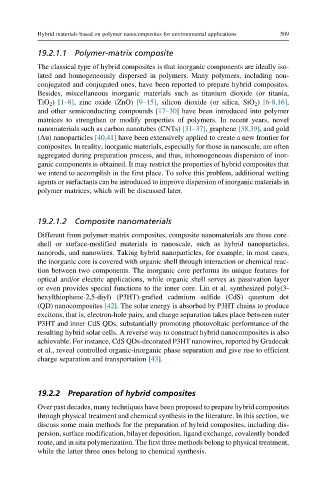Page 556 - Polymer-based Nanocomposites for Energy and Environmental Applications
P. 556
Hybrid materials based on polymer nanocomposites for environmental applications 509
19.2.1.1 Polymer-matrix composite
The classical type of hybrid composites is that inorganic components are ideally iso-
lated and homogeneously dispersed in polymers. Many polymers, including non-
conjugated and conjugated ones, have been reported to prepare hybrid composites.
Besides, miscellaneous inorganic materials such as titanium dioxide (or titania,
TiO 2 ) [1–8], zinc oxide (ZnO) [9–15], silicon dioxide (or silica, SiO 2 ) [6-8,16],
and other semiconducting compounds [17–30] have been introduced into polymer
matrices to strengthen or modify properties of polymers. In recent years, novel
nanomaterials such as carbon nanotubes (CNTs) [31–37], graphene [38,39], and gold
(Au) nanoparticles [40,41] have been extensively applied to create a new frontier for
composites. In reality, inorganic materials, especially for those in nanoscale, are often
aggregated during preparation process, and thus, inhomogeneous dispersion of inor-
ganic components is obtained. It may restrict the properties of hybrid composites that
we intend to accomplish in the first place. To solve this problem, additional wetting
agents or surfactants can be introduced to improve dispersion of inorganic materials in
polymer matrices, which will be discussed later.
19.2.1.2 Composite nanomaterials
Different from polymer-matrix composites, composite nanomaterials are those core-
shell or surface-modified materials in nanoscale, such as hybrid nanoparticles,
nanorods, and nanowires. Taking hybrid nanoparticles, for example, in most cases,
the inorganic core is covered with organic shell through interaction or chemical reac-
tion between two components. The inorganic core performs its unique features for
optical and/or electric applications, while organic shell serves as passivation layer
or even provides special functions to the inner core. Lin et al. synthesized poly(3-
hexylthiophene-2,5-diyl) (P3HT)-grafted cadmium sulfide (CdS) quantum dot
(QD) nanocomposites [42]. The solar energy is absorbed by P3HT chains to produce
excitons, that is, electron-hole pairs, and charge separation takes place between outer
P3HT and inner CdS QDs, substantially promoting photovoltaic performance of the
resulting hybrid solar cells. A reverse way to construct hybrid nanocomposites is also
achievable. For instance, CdS QDs-decorated P3HT nanowires, reported by Gradecak
et al., reveal controlled organic-inorganic phase separation and give rise to efficient
charge separation and transportation [43].
19.2.2 Preparation of hybrid composites
Over past decades, many techniques have been proposed to prepare hybrid composites
through physical treatment and chemical synthesis in the literature. In this section, we
discuss some main methods for the preparation of hybrid composites, including dis-
persion, surface modification, bilayer deposition, ligand exchange, covalently bonded
route, and in situ polymerization. The first three methods belong to physical treatment,
while the latter three ones belong to chemical synthesis.

